
Concept explainers
(a)
Interpretation:
The structure is to be drawn, and the correct IUPAC name for the given trivial name is to be provided.
Concept introduction:
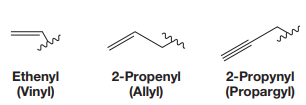
Trivial names such as iso and neo, sec, tert are used to indicate the alkyl groups and their structure as shown below:
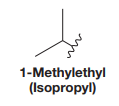
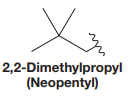
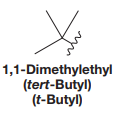
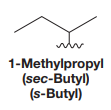
The root names of ketones are derived from those of the parent
Answer to Problem E.23P
The correct IUPAC name for the given trivial name

Explanation of Solution
The name for the given molecule is

The prefix di represents that there are two vinyl groups attached to the carbonyl carbon atom in ketone. Thus, the structure for

While writing the IUPAC name for ketones, the longest continuous carbon chain containing the ketone functional group is to be determined, and it is numbered such that the carbonyl carbon receives the lowest possible numbering. Using this rule, the numbering for the above structure is

The longest continuous carbon chain has five carbon atoms, and the carbonyl carbon is at number 3. Thus, the root name for this will be
The structure of the molecule is drawn and the correct IUPAC name is written for the given trivial name.
(b)
Interpretation:
The structure is to be drawn, and the correct IUPAC name for the given trivial name is to be provided.
Concept introduction:
Ketones consist of two alkyl or aryl groups attached to a carbonyl group, and their trivial names consist of identifying the alkyl or aryl groups and listing them both before the word ketone. Alkyl groups can be alkenes, alkynes, or benzene derivatives. Some of the most common names for alkenes and alkynes are vinyl, allyl, or propargyl. Their structures are as follows:

Trivial names such as iso and neo, sec, tert are used to indicate the alkyl groups and their structure as shown below:




The root names of ketones are derived from those of the parent alkanes, defined by the longest continuous chain of carbon atoms that contains the functional group. For a ketone, drop the -e from the alkane name and add the ending one. To indicate the position of a substituent on a ketone, number the chain in the manner that gives the carbonyl carbon atom the lowest possible locator number. In cyclic ketones, it is understood that the carbonyl carbon atom is C1.
Answer to Problem E.23P
The correct IUPAC name for the given trivial name
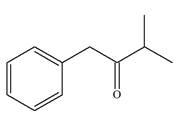
Explanation of Solution
The name for the given molecule is

While writing the IUPAC name for ketones, the longest continuous carbon chain containing the ketone functional group is to be determined, and it is numbered such that the carbonyl carbon receives the lowest possible numbering. Using this rule, the numbering for the above structure is
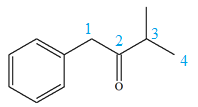
The longest continuous carbon chain has four carbon atoms, and the carbonyl carbon is at number 2. Thus, the root name for this will be
The structure of the molecule is drawn, and the correct IUPAC name is written for the given trivial name.
(c)
Interpretation:
The structure is to be drawn, and the correct IUPAC name for the given trivial name is to be provided.
Concept introduction:
Ketones consist of two alkyl or aryl groups attached to a carbonyl group, and their trivial names consist of identifying the alkyl or aryl groups and listing them both before the word ketone. Alkyl groups can be alkenes, alkynes, or benzene derivatives. Some of the most common names for alkenes and alkynes are vinyl, allyl, or propargyl. Their structures are as follows:

Trivial names such as iso and neo, sec, tert are used to indicate the alkyl groups and their structure as shown below:




The root names of ketones are derived from those of the parent alkanes, defined by the longest continuous chain of carbon atoms that contains the functional group. For a ketone, drop the -e from the alkane name and add the ending one. To indicate the position of a substituent on a ketone, number the chain in the manner that gives the carbonyl carbon atom the lowest possible locator number. In cyclic ketones, it is understood that the carbonyl carbon atom is C1.
Answer to Problem E.23P
The correct IUPAC name for the given trivial name
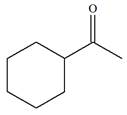
Explanation of Solution
The name for the given molecule is

While writing the IUPAC name for ketones, the longest continuous carbon chain containing the ketone functional group is to be determined, and it is numbered such that the carbonyl carbon receives the lowest possible numbering. Using this rule, the numbering for the above structure is
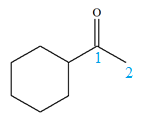
The longest continuous carbon chain has two carbon atoms, and the carbonyl carbon is at number 1. Thus, the root name for this will be
The structure of the molecule is drawn, and the correct IUPAC name is written for the given trivial name.
(d)
Interpretation:
The structure is to be drawn, and the correct IUPAC name for the given trivial name is to be provided.
Concept introduction:
Ketones consist of two alkyl or aryl groups attached to a carbonyl group, and their trivial names consist of identifying the alkyl or aryl groups and listing them both before the word ketone. Alkyl groups can be alkenes, alkynes, or benzene derivatives. Some of the most common names for alkenes and alkynes are vinyl, allyl, or propargyl. Their structures are as follows:

Trivial names such as iso and neo, sec, tert are used to indicate the alkyl groups and their structure as shown below:




The root names of ketones are derived from those of the parent alkanes, defined by the longest continuous chain of carbon atoms that contains the functional group. For a ketone, drop the -e from the alkane name and add the ending one. To indicate the position of a substituent on a ketone, number the chain in the manner that gives the carbonyl carbon atom the lowest possible locator number. In cyclic ketones, it is understood that the carbonyl carbon atom is C1.
Answer to Problem E.23P
The correct IUPAC name for the given trivial name
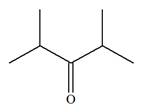
Explanation of Solution
The name for the given molecule is

There is no other substituent present; thus, the structure for the compound is

While writing the IUPAC name for ketones, the longest continuous carbon chain containing the ketone functional group is to be determined, and it is numbered such that the carbonyl carbon receives the lowest possible numbering. Using this rule, the numbering for the above structure is
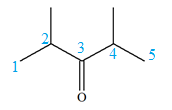
The longest continuous carbon chain has five carbon atoms, and the carbonyl carbon is at number 3. Thus, the root name for this will be
The structure of the molecule is drawn, and the correct IUPAC name is written for the given trivial name.
(e)
Interpretation:
The structure is to be drawn, and the correct IUPAC name for the given trivial name is to be provided.
Concept introduction:
Ketones consist of two alkyl or aryl groups attached to a carbonyl group, and their trivial names consist of identifying the alkyl or aryl groups and listing them both before the word ketone. Alkyl groups can be alkenes, alkynes, or benzene derivatives. Some of the most common names for alkenes and alkynes are vinyl, allyl, or propargyl. Their structures are as follows:

Trivial names such as iso and neo, sec, tert are used to indicate the alkyl groups and their structure as shown below:




The root names of ketones are derived from those of the parent alkanes, defined by the longest continuous chain of carbon atoms that contains the functional group. For a ketone, drop the -e from the alkane name and add the ending one. To indicate the position of a substituent on a ketone, number the chain in the manner that gives the carbonyl carbon atom the lowest possible locator number. In cyclic ketones, it is understood that the carbonyl carbon atom is C1.
Answer to Problem E.23P
The correct IUPAC name for the given trivial name
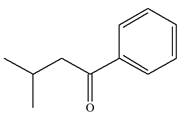
Explanation of Solution
The name for the given molecule is

There is no other substituent present; thus, the structure for the compound is
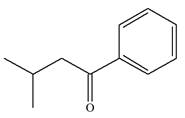
While writing the IUPAC name for ketones, the longest continuous carbon chain containing the ketone functional group is to be determined, and it is numbered such that the carbonyl carbon receives the lowest possible numbering. Using this rule, the numbering for the above structure is
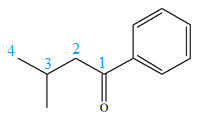
The longest continuous carbon chain has four carbon atoms, and the carbonyl carbon is at number 1. Thus, the root name for this will be
The structure of the molecule is drawn, and the correct IUPAC name is written for the given trivial name.
Want to see more full solutions like this?
Chapter E Solutions
Organic Chemistry: Principles and Mechanisms (Second Edition)
- Write all of Me Possible Products For each Of the Following reactions. In each case identity all pains of enantiomers, all digsterzoners and all Meso compounds 9. 11-60 11-0-11 V-G Η Η H ~ C-11 +HB+ - 1 H b. पन्ना 171-0-11 H-C-H Н C-C=c-call +HBr Perendez ==arrow_forwardHow can i draw the mechanisms for this molecule?arrow_forwarda. Discuss and explain he difference IN Stability between the Chai and Boat Гольцу от судомехане b. For the Following Molecule draw both possible Clain conformations and explain which one is more stable and for what Reason. H. CH₂ CH₂ H "Harrow_forward
 Chemistry for Today: General, Organic, and Bioche...ChemistryISBN:9781305960060Author:Spencer L. Seager, Michael R. Slabaugh, Maren S. HansenPublisher:Cengage Learning
Chemistry for Today: General, Organic, and Bioche...ChemistryISBN:9781305960060Author:Spencer L. Seager, Michael R. Slabaugh, Maren S. HansenPublisher:Cengage Learning Organic Chemistry: A Guided InquiryChemistryISBN:9780618974122Author:Andrei StraumanisPublisher:Cengage Learning
Organic Chemistry: A Guided InquiryChemistryISBN:9780618974122Author:Andrei StraumanisPublisher:Cengage Learning Organic And Biological ChemistryChemistryISBN:9781305081079Author:STOKER, H. Stephen (howard Stephen)Publisher:Cengage Learning,
Organic And Biological ChemistryChemistryISBN:9781305081079Author:STOKER, H. Stephen (howard Stephen)Publisher:Cengage Learning, General, Organic, and Biological ChemistryChemistryISBN:9781285853918Author:H. Stephen StokerPublisher:Cengage LearningChemistry: Matter and ChangeChemistryISBN:9780078746376Author:Dinah Zike, Laurel Dingrando, Nicholas Hainen, Cheryl WistromPublisher:Glencoe/McGraw-Hill School Pub Co
General, Organic, and Biological ChemistryChemistryISBN:9781285853918Author:H. Stephen StokerPublisher:Cengage LearningChemistry: Matter and ChangeChemistryISBN:9780078746376Author:Dinah Zike, Laurel Dingrando, Nicholas Hainen, Cheryl WistromPublisher:Glencoe/McGraw-Hill School Pub Co Chemistry: Principles and PracticeChemistryISBN:9780534420123Author:Daniel L. Reger, Scott R. Goode, David W. Ball, Edward MercerPublisher:Cengage Learning
Chemistry: Principles and PracticeChemistryISBN:9780534420123Author:Daniel L. Reger, Scott R. Goode, David W. Ball, Edward MercerPublisher:Cengage Learning





